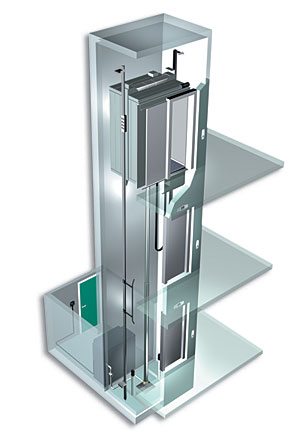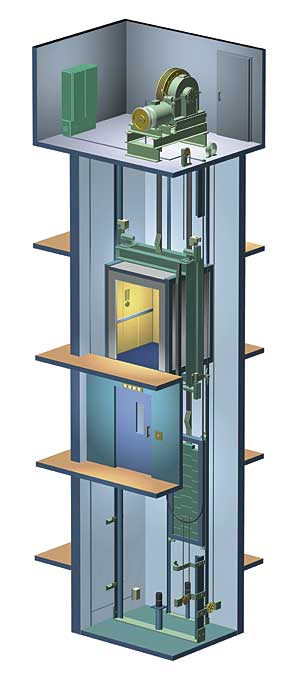New Elevator Technology: The Machine Room-Less Elevator
Â
 |
 |
To lower the car, the elevator control system sends a signal to the valve. When the valve opens, the fluid that has collected in the cylinder can flow out into the fluid reservoir. The weight of the car and the cargo pushes down on the piston, which drives the fluid into the reservoir. The car gradually descends. To stop the car at a lower floor, the control system closes the valve again.
There are three types of hydraulic elevators, known as "in-ground," "holeless" or "roped" systems.
An in-ground elevator requires a deep hole below the bottom landing because the cylinder goes down into the ground as far as the elevator travels up. Typical in-ground installations use a PVC casing to protect the cylinder from electrolytic and other corrosive chemical actions that could lead to future underground oil leaks.
Holeless elevators are typically used for buildings where it is not possible to drill a cylinder hole. They do not employ a conventional piston/casing arrangement and therefore do not require a hole to be dug for the hydraulic cylinder. In most designs the cab is lifted by a pair of hydraulic jacks, one on each side of the elevator. They are used if a limited amount of travel is required. Sometimes the hydraulic piston (plunger) consists of telescoping steel tubes that allow for increased travel.
Roped hydraulic elevators use a combination of hydraulics and a complex indirect attachment to the cab. Most applications are in existing buildings where drilling a hole for jack assemblies is impractical or more travel is required than would be possible with a holeless direct-acting elevator.
Â
Â
 |
 |
The advantages of the hydraulic elevator include:
- No overhead machine room is necessary
- Elevator hoistway dimensions are optimized
- Loads are distributed to load bearing walls-there are no overhead structural requirements
- Machine rooms can be located remotely
- Installation costs are generally less than those for conventional traction roped systems
Â
The drawbacks of the hydraulic elevator include:
- Machine room needed for pump unit and control system
- Limited speed and performance
- High noise levels as compared to other systems
- Odor from heated oil
- Environmental concerns due to significant use of oil
- Poor ride quality as compared with other systems
Â
Traction Elevator
The most recognizable elevator design is that of the traction elevator. Ropes are attached to the elevator car and looped around a hoist machine with deep grooves in its circumference known as a sheave. The sheave grips the hoist ropes, so when the sheave, which is connected to an electric motor, rotates, the ropes move too. When the motor turns one way, the sheave raises the elevator; when the motor turns the other way, the sheave lowers the elevator.
In gearless elevators, which have traditionally been used for very tall buildings or to achieve exceptionally fast speeds, the motor rotates the sheaves directly, allowing speeds up to 3,000 fpm (35 mph).
In geared elevators, which have traditionally been used for mid-sized office and residential buildings, the motor turns a gear train that rotates the sheave. Mechanical limitations typically limit the speed to 450 fpm. Traditionally, the sheave, the motor and the control system are all housed in a machine room above the elevator shaft. From the building exterior, the machine room typically appears as a box on the rooftop. Other configurations can be utilized that eliminate the need for the overhead machine room by placing components at or near the first landing-a "basement" configuration-or elsewhere along the shaft (or hoistway).
The ropes that lift the car are also connected to a counterweight, which hangs on the opposite side of the sheave. The counterweight weighs about the same as the car filled to 40 percent capacity. In other words, when the car is 40 percent full, the counterweight and the car are perfectly balanced. With equal loads on each side of the sheave, it only takes minimal force to tip the balance one-way or the other.
Â
Â
|
Â
Â
Both the elevator car and the counterweight ride on guide rails, which run along the sides of the elevator shaft. The rails keep the car and counterweight from swaying back and forth, and they also work with the safety system to stop the car in an emergency.











